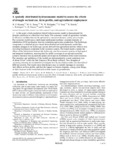Por favor, use este identificador para citar o enlazar este ítem:
http://www.alice.cnptia.embrapa.br/alice/handle/doc/856312Registro completo de metadatos
| Campo DC | Valor | Lengua/Idioma |
|---|---|---|
| dc.contributor.author | MANETA, M. P. | pt_BR |
| dc.contributor.author | TORRES, M. O. | pt_BR |
| dc.contributor.author | WALLENDER, W. W. | pt_BR |
| dc.contributor.author | VOSTI, S. | pt_BR |
| dc.contributor.author | HOWITT, R. | pt_BR |
| dc.contributor.author | RODRIGUES, L. N. | pt_BR |
| dc.contributor.author | BASSOI, L. H. | pt_BR |
| dc.contributor.author | PANDAY. S. | pt_BR |
| dc.date.accessioned | 2011-04-09T18:17:11Z | - |
| dc.date.available | 2011-04-09T18:17:11Z | - |
| dc.date.created | 2010-06-29 | pt_BR |
| dc.date.issued | 2009 | pt_BR |
| dc.identifier.citation | Water Resources Research, v. 45, 2009. | pt_BR |
| dc.identifier.uri | http://www.alice.cnptia.embrapa.br/alice/handle/doc/856312 | pt_BR |
| dc.description | In this paper a high-resolution linked hydroeconomic model is demonstrated for drought conditions in a Brazilian river basin. The economic model of agriculture includes 13 decision variables that can be optimized to maximize farmers' yearly net revenues. The economic model uses a multi-input multioutput nonlinear constant elasticity of substitution (CES) production function simulating agricultural production. The hydrologic component is a detailed physics-based three-dimensional hydrodynamic model that simulates changes in the hydrologic system derived from agricultural activity while in turn providing biophysical constraints to the economic system. The linked models capture the effects of the interactions between the hydrologic and the economic systems at high spatial and temporal resolutions, ensuring that the model converges to an optimal economic scenario that takes into account the spatial and temporal distribution of the water resources. The operation and usefulness of the models are demonstrated in a rural catchment area of about 10 km2 within the São Francisco River Basin in Brazil. Two droughts of increasing intensity are simulated to investigate how farmers behave under rain shortfalls of different severity. The results show that farmers react to rainfall shortages to minimize their effects on farm profits, and that the impact on farmers depends, among other things, on their location in the watershed and on their access to groundwater. | pt_BR |
| dc.language.iso | eng | eng |
| dc.rights | openAccess | eng |
| dc.title | A spatially distributed hydroeconomic model to assess the effects of drought on land use, farm profits, and agricultural employment. | pt_BR |
| dc.type | Artigo de periódico | pt_BR |
| dc.date.updated | 2011-04-10T11:11:11Z | pt_BR |
| dc.subject.thesagro | Bacia hidrográfica | pt_BR |
| dc.subject.thesagro | Seca | pt_BR |
| dc.subject.thesagro | Uso da terra | pt_BR |
| dc.subject.thesagro | Exploração agrícola | pt_BR |
| dc.description.notes | Meta 2010 | pt_BR |
| riaa.ainfo.id | 856312 | pt_BR |
| riaa.ainfo.lastupdate | 2010-09-13 | pt_BR |
| dc.identifier.doi | 10.1029/2008WR007534 | pt_BR |
| dc.contributor.institution | M. P. MANETA; M. O. TORRES; W. W. WALLENDER; S. VOSTI; R. HOWITT; LINEU NEIVA RODRIGUES, CPAC; LUIS HENRIQUE BASSOI, CPATSA; S. PANDAY. | pt_BR |
| Aparece en las colecciones: | Artigo em periódico indexado (CPAC)  | |
Ficheros en este ítem:
| Fichero | Descripción | Tamaño | Formato | |
|---|---|---|---|---|
| Bassoi.pdf | 624,27 kB | Adobe PDF |  Visualizar/Abrir |









